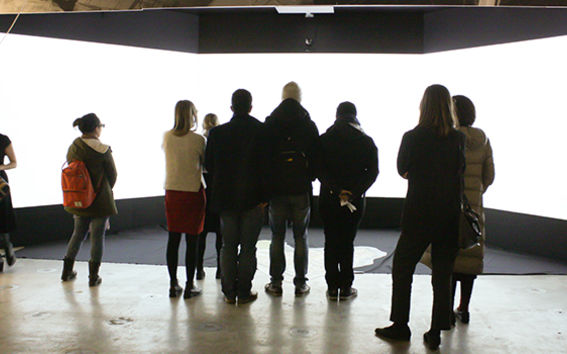Prototyping Future Service Environments

In the spring 2014 Ilkka Kelaranta and Olli Poutanen started a tandem master’s thesis. There were many ideas but it was hard to settle for a specific topic. The spring consisted of sense-making and making way for new thoughts. In the end, they had a plan and an innovative idea. It combined Poutanen’s interest and expertise in kinesthetic experience and Kelaranta’s skills in game design and creating virtual environments. What is more, they had recognized a need and a possible solution.
The revolution of the ways when and how we use services has already started. Many services can be accessed through a personal portable device anywhere. Next step could be a more seamless integration of service offerings in our environment and our ways of interacting with them. Examples range from ordering and paying coffee already on the way to the café to medical drones ready to be summoned when needed. Especially when design decisions have to be made about the design of physical arrangements in the urban space, being able to test these services in advance is valuable.
Kinesthesia
Built environment can be studied from many levels of inquiry. A macro scale could entail looking at flows of material, energy and people, or economics of a city. On the micro scale, there is interaction between a single person and their environment.
The bodily sensation of movement, kinesthesia, is an important way of experiencing the immediate environment. A system or service entails a kinesthetic experience and interaction even if those are not deliberately designed. Our environment and artefacts offer different pre-choreographies, intended ways for us to bodily interact with them. For example the pre-choreography of lifting a coffee mug is shaped by the ear of the mug: you usually put your fingers through the loop. A pre-choreography can be ignored but it has an impact on the space of possible interactions.
Cases: Drone Delivery Game and Munkkiniemi Lights
In the projects at hand, Ilkka Kelaranta and Olli Poutanen have modelled a virtual 3D environment that can be experienced using a head mounted display (Oculus Rift) tracking head movements and supplying visual information, and a control surface (Virtuix Omni) that tracks the movements of a pedestrian test subject. The ability to build immersive virtual environments with kinesthetic experiences opens up a venue for movement oriented interaction design.
The first proof of concept of this way of prototyping service experiences was a drone delivery game, realized in 2014. The game happens in Aalto University’s Otaniemi campus. The idea is to test drones offering services (such as delivering packages) in an urban environment. In this case, the virtual model enables user testing of services that don’t exist yet and are costly to implement physically.
The prototype number two features testing the Munkkiniemi strand path intelligent lighting. This other case is also to test what are the limitations of virtual user testing. The idea is to test the same scenario both in the real environment and virtually and compare the two. This project will take place in the spring 2015.






